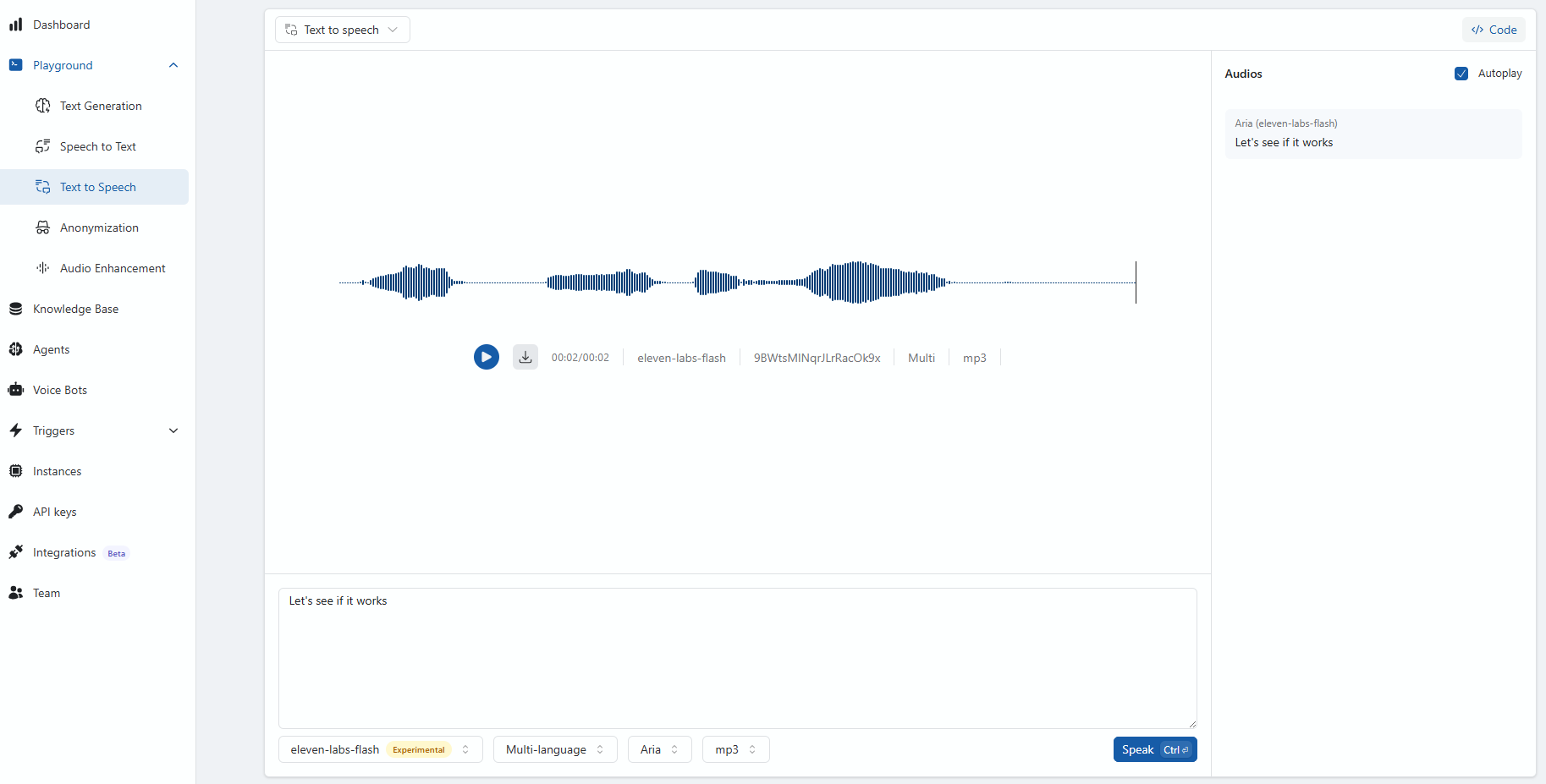SipPulse AI - Text to Speech Conversion
Text to Speech Interface
The SipPulse AI platform provides powerful capabilities for converting text into natural-sounding speech. This section documents how to use the Text to Speech tool to transform written content into audio.

Accessing the Text to Speech Interface
Navigating to the Tool:
- Access the left sidebar menu
- Click on "Playground" to expand the options
- Select "Text to Speech" to open the conversion interface
Main Interface Components:
- Text Input Area: Central zone for entering the text you want to convert
- Audio Visualization: Waveform display of the generated audio
- Playback Controls: Play button, download option, and timeline
- Generated Audio List: Right panel showing previously generated audio files
Configuration Options
Model and Voice Settings:
- Model: Select from available TTS models (e.g., "eleven-labs-flash")
- Language Options: Choose "Multi-language" or select a specific language
- Voice Selection: Select from different voice options (e.g., "Aria")
- Format: Choose the output audio format (e.g., "mp3")
Advanced Features:
- Autoplay: Option to automatically play audio after generation
- Voice Customization: Some models allow adjusting voice characteristics
- Experimental Features: Access to new capabilities (tagged as "Experimental")
Keyboard Shortcuts:
- Press "Ctrl+Enter" to quickly generate speech from the entered text
- Use playback controls to manage audio playback
Speech Generation Process
Text Preparation:
- Enter the text you want to convert into the text input area
- Format your text with appropriate punctuation for natural speech patterns
- Consider using SSML tags for advanced voice control (if supported by the selected model)
Configuration Selection:
- Choose the appropriate model for your needs
- Select the desired voice that matches your content
- Configure language settings if generating speech in specific languages
Generating Speech:
- Click the "Speak" button or use the Ctrl+Enter shortcut
- The system processes your text and generates the audio
- The waveform visualization displays once processing is complete
Review and Export:
- Listen to the generated audio using the playback controls
- Download the audio file using the download button
- Regenerate with different settings if needed
API Integration
SipPulse AI provides a RESTful API for integrating text-to-speech capabilities directly into your applications. Below are examples of how to use the API in different programming languages.
API Parameters
- model: Specifies the TTS model (e.g.,
eleven-labs-flash) - voice: Determines which voice to use (e.g.,
aria) - format: Output audio format (e.g.,
mp3) - api-key: Your SipPulse API authentication key
Python Example
import requests
url = 'https://api.sippulse.ai/tts/synthesize'
headers = {
'accept': 'application/json',
'content-type': 'application/json',
'api-key': '$SIPPULSE_API_KEY'
}
data = {
'text': "Let's see if it works",
'model': 'eleven-labs-flash',
'voice': 'aria',
'format': 'mp3'
}
response = requests.post(url, json=data, headers=headers)
if response.status_code == 200:
with open('output.mp3', 'wb') as f:
f.write(response.content)
print("Audio file created successfully!")
else:
print(f"Error: {response.status_code}")
print(response.text)Node.js Example
const fetch = require('node-fetch');
const fs = require('fs');
const url = 'https://api.sippulse.ai/tts/synthesize';
const data = {
text: "Let's see if it works",
model: 'eleven-labs-flash',
voice: 'aria',
format: 'mp3'
};
const options = {
method: 'POST',
headers: {
'accept': 'application/json',
'content-type': 'application/json',
'api-key': '$SIPPULSE_API_KEY'
},
body: JSON.stringify(data)
};
fetch(url, options)
.then(response => {
if (!response.ok) {
throw new Error(`HTTP error! Status: ${response.status}`);
}
return response.buffer();
})
.then(buffer => {
fs.writeFileSync('output.mp3', buffer);
console.log('Audio file created successfully!');
})
.catch(error => console.error('Error:', error));cURL Example
curl -X 'POST' \
'https://api.sippulse.ai/tts/synthesize' \
-H 'accept: application/json' \
-H 'content-type: application/json' \
-H 'api-key: $SIPPULSE_API_KEY' \
-d '{
"text": "Let'\''s see if it works",
"model": "eleven-labs-flash",
"voice": "aria",
"format": "mp3"
}' \
--output output.mp3Usage Considerations
Voice Quality Optimization:
- Keep sentences at a natural length for more realistic speech patterns
- Use appropriate punctuation to control pacing and intonation
- Test different voices to find the best match for your content
Cost Management:
- Be aware that costs typically scale with the length of the text
- Consider breaking very long texts into smaller segments
- Use the appropriate model based on quality vs. cost requirements
Performance Factors:
- Higher quality models may have longer processing times
- Very long texts will take more time to process
- Some voices may be optimized for specific languages or content types
Content Guidelines:
- Avoid generating speech with sensitive personal information
- Be aware of usage policies regarding impersonation or deception
- Follow local regulations regarding synthetic voice generation
By using the SipPulse AI Text to Speech tool, you can efficiently convert written content into natural-sounding speech for a wide range of applications, including voice assistants, educational content, accessibility features, and more.
